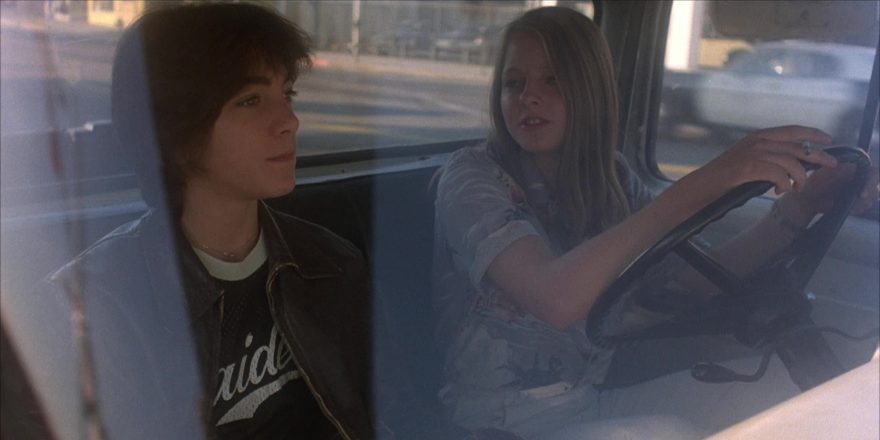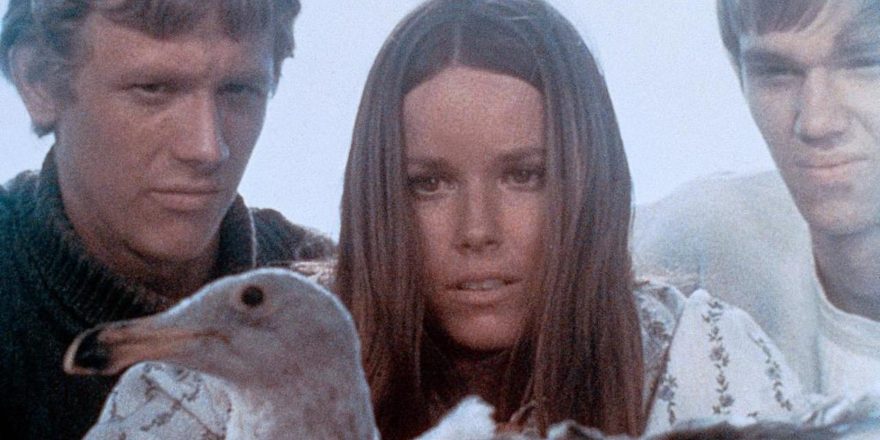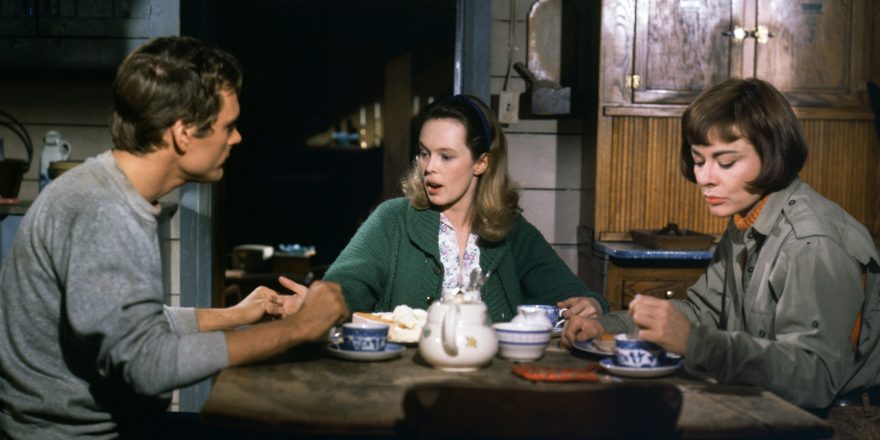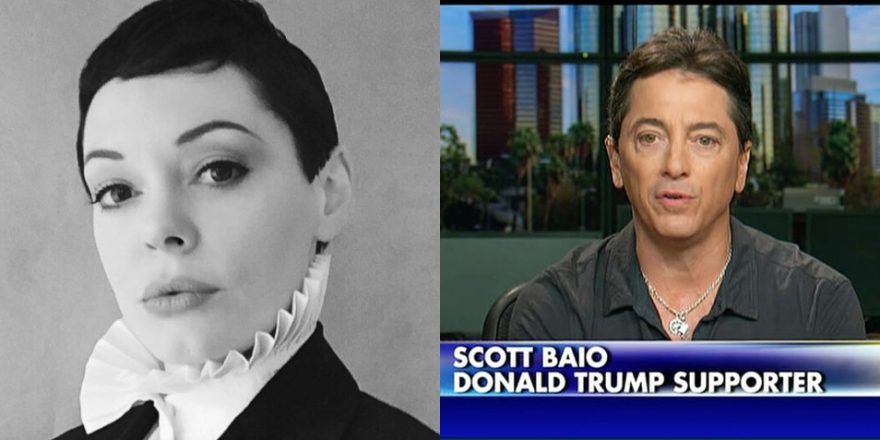If only regarded as a Jodie Foster vehicle, Adrian Lyne’s Foxes (1980) represents an extraordinary piece of cinema. Along with several of her other films of the approximate era (1980’s Carny and The Hotel New Hampshire, from 1984), Foxes represents the coming of age of one of the greatest child actors of all time (rivaled, in my personal canon, only by Hayley Mills, Kristy McNichol, Dean Stockwell, Billy Mumy, and a few others), an often rocky period for those miniature adults raised in front of the Hollywood camera, many of whom fail to negotiate the transition to grown-up screen success. In the case of latent lesbian child thespians, whose early roles depend on their “tomboy” persona, the passage is even more fraught. (Foster’s tomboy status was particularly well defined in her early TV roles on shows like The Courtship of Eddie’s Father, My Three Sons and Paper Moon.) Jodie Foster is an exceptional case inasmuch as her early, controversial film roles, even as a child, were highly sexualized in a more feminized direction, particularly in Bugsy Malone and Taxi Driver (both 1976), the latter in which she infamously played a 13-year-old prostitute named Iris. These femme roles, besides being disconcertingly sexual, amounted to a kind of drag for the decidedly tomboyish actor, who even tended to dress in masculine attire in guest TV spots and interviews.
So what to do with the tomboy when s/he reaches adolescence? (The very term “tomboy” is now used contentiously in conversations about gender.) In the seventies, the answer was quite simple: confuse the issue by pairing them up with a feminized boy, a not uncommon figure of the era. In Little Darlings, tomboy Kristy McNichol (who, like Foster, came out as a lesbian much later in her career) is paired up with a very feminized, passive Matt Dillon, who looks almost like her twin in the film. In Foxes, Foster is paired up with not one but two similarly feminized boys, Brad (a cute, pre-pubescent Scott Baio, who also appeared with her in Bugsy Malone), and Scott (Robert Romanus), whose long, full dark hair and doe eyes make him, if not sexually ambiguous, then certainly a suitably sensitive and non-threatening love object. (He would appear two years later in more butch mode in Fast Times at Ridgemont High.) Even so, Foster, as Jeanie, shows little sexual interest in Scott or any other boy in the film, as opposed to her three best friends, Annie (Cherie Currie of The Runaways), Madge (Marilyn Kagan) and Deirdre (Kandice Stroh), who can think of nothing else.
Full disclosure: in the eighties I got a Jodie Foster tattoo, based on a photograph of her from Foxes. When I was aligned with the punk movement back then, Foster was a major icon for hardcore kids. It was her notorious role opposite a bemohawked Robert De Niro in Scorsese’s Taxi Driver (along with Salinger’s The Catcher in the Rye) that inspired John Hinckley, Jr. to attempt to assassinate Ronald Reagan in 1981. In an interview for PBS, an eerily composed Foster, dressed in her typical masculine garb, fields questions from reporters about the mash notes that Hinckley sent her which spell out his plan to win her love by killing the President. This incident, combined with her somewhat twisted, carnal teenage roles in such movies as The Little Girl That Lived Down the Lane and Carny, inspired a hardcore band to name itself Jodie Foster’s Army (JFA), and at least five punk bands to write songs about Jodie and Hinckley, my personal favorite being The Crucifucks’ “Hinkley Had a Vision.”
Foxes, released a year before the Hinckley incident, can be regarded as the ultimate Jodie Foster fetish film. From the opening shot, in which the camera pans from her feet to her body while she sleeps, accompanied by the romantic strains of the Giorgio Moroder score (Donna Summer’s “On the Radio” and Janis Ian’s “Fly Too High,” both produced by Moroder, play throughout the film), the reverential tone is set. The mood of the film is lush, a hazy, filtered look reminiscent of Sapphic softcore seventies films such as Bilitis. The camera lovingly reveals the contents of her bedroom – a John Travolta poster (another feminized, repressed gay icon), a tube of Clearasil, a half-eaten Twinkie – as well as the three other girls, her best friends, who are languidly draped over various pieces of furniture as they slumber.
The girls have trouble waking up Annie, who has washed down too many Quaaludes with beer and wine, as is her wont. This is peak Currie, the teen rock star essentially playing herself in her big-screen debut. With her long, bleached blond hair and wiry frame, her skinniness compounded by tight jeans, braces and boots, she is the straight, feminine-but-tough counterpart to Foster’s more masculine Jeanie and her male attire – a brown vest over a white shirt and khaki, pleated pants. All the girls except Jeanie are sexually precocious and boy-crazy: Deirdre says of one of her male conquests, “I never said I want to go with him. I said I want to ball him.” After Jeanie chats with her mom (a disconcertingly unhinged Sally Kellerman), who is in bed with her latest boyfriend, the girls leave the house, only to be ambushed by Annie’s psycho cop father, who proceeds to pummel her and chase her through a clothesline in a sequence worthy of Kojak. “What are we going to do?” says one of the girls. “Call the cops,” says Jeanie sarcastically.
The teenagers in Foxes are constantly confronted by the antic, hysterical acting out of their parents and teachers, leaving them shaking their heads at their elders’ absurd behavior. A home economics teacher freaks out when Jeanie holds a doll upside down by the foot in a baby bathing exercise, to which Jeanie evenly replies, “It’s a rubber doll, Mrs. Steiner.” Jeanie laments to another teacher that Annie’s cop dad handcuffed her sister when “all she wanted to do was go out and get an abortion. No shit, Mr. Simmons.” While driving up and down Hollywood Boulevard in Jeanie’s improbable black pickup truck, searching for Annie (a scene featuring candid, documentary-style shots of real street people), Jeanie talks to a black pimp named Dragon, prompting Madge to say that if they aren’t careful, “The next thing you know you’re out on the Boulevard dressed like the Pointer Sisters.” These teens are wise beyond their years, but already world-weary. They realize that they all want to grow up too fast, destined to become their parents, or any other adult, whom they hate with a passion.
The plot of Foxes is almost incidental, a pretext for a series of scenes and set-pieces that fetishize youth to the point of commoditization. The director, Adrian Lyne, came out of the advertising world like his fellow Brit, Alan Parker. Both directors would invade Hollywood in the 1980s with a series of flashy, hot-button movies that highlighted their commercial sensibilities, Lyne with such zeitgeist potboilers as Flashdance, Fatal Attraction and Indecent Proposal, Parker, starting in the seventies, with slick, psychosexual mood pieces like Bugsy Malone, Midnight Express and Angel Heart. Treating feature films as extended commercials was somewhat of a novelty at the time, but it did introduce a certain pop pleasure to Hollywood, if an amoral and emotionally manipulative one (Lyne’s 1997 adaptation of Nabokov’s Lolita is truly creepy), not to mention a strong element of “straight camp.” Foxes at times plays as if Roger Vadim had directed a PSA on teenage female hygiene.
After Annie confesses to Jeanie her unsettling sexual fantasy of her father as a cross between Cary Grant and a Motocross driver, the four girls head for a rock concert for which Jeanie’s father (British pop star Adam Faith), a concert promoter, has provided them tickets. In the parking lot, the foursome is harassed by four cat-calling metalheads, who call them dykes. The girls respond by mock-making out with each other, a weak concession to – or denial of – Foster’s potent lesbian persona, evidenced here by her electric blue satin shirt tucked into pleated white pants accessorized by a thin leather belt. The scene that follows is one of my favorites, as Jeanie, after another squabble with her loony mother, retreats to the living room to recline and listen to Boston’s “More Than A Feeling.” She then returns to her mother’s bed to read her Plato’s Republic as a bedtime story. Such scenes lend the film the quality of a hodgepodge of stylistic and thematic references in search of an auteur.
At this point of the film, we are introduced to Jay (a suitably squirrelly Randy Quaid), 16-year-old Madge’s secret older boyfriend. The plump Madge, with her severe eyewear and frumpy style, is a standard teen-movie trope in wobbly high heels. After blithely giving up her virginity to Jay, who is also in the music business, he heads to New York, leaving his jailbait girlfriend and her three besties to live in his house, a refuge from the world of insane grown-ups. The girls throw a very adult dinner party, replete with champagne, evening dresses, cigarette holders and tuxedos for the boys (Baio, of course, sports the classic tuxedo T-shirt borrowed from Carrie), the kids acting like adults as in Parker’s Bugsy Malone. The private affair is soon crashed by a gaggle of teenagers (among them Laura Dern, wearing very thick glasses, who talks about the pill versus the diaphragm), turning the event into a full-on, adult-unsupervised rager. In one telling moment, a randy boy says to Jeanie, “Come outside, I’d like to show you something.” “No thanks, I’ve seen it,” deadpans Foster, speaking for every lesbian ever hit on by a clueless boy. Moments later, Jeanie gives her erstwhile boyfriend the final brush-off, summarily putting an end to the obligatory heterosexual interests demanded by a teenage exploitation film. The party is soon crashed by a trio of slightly older teen heathens who trash the place, one older boy in particular chasing Brad through the house spectacularly and beating him, setting up the final showdown to come between two lost generations of teens.
The film oozes along with its louche, gauzy cinematography and its slow tracking shots into the teenagers, kind of like Little Darlings directed by Luchino Visconti. Jeanie and her mother finally have their big showdown, giving Sally Kellerman a chance to chew the scenery in fine form. “You booze, you dope, you sleep with whoever,” she complains. “I don’t even know who you are. You look like kids, but you don’t act like ‘em! You’re short 40-year olds, and you’re tough ones.” The over-the-top dialogue reinforces the camp excesses of the film, which Kellerman’s delivery does nothing to ameliorate. “Just because they fit you with a diaphragm doesn’t make you a woman,” she declares belligerently as she stands in the hallway. She finally dissolves into a fit of self-pity: “You make me hate my hips. I hate my hips.” Parents never fare well in teen exploitation movies, but in Lyne’s cosmology – the arthouse director slumming in the teen genre – they become absolutely monstrous.
A few more redundant scenes fill out the film before the Keystone Cops-style finale. In one of them, Foster and Baio slump languidly in her black pickup truck drinking prominently displayed cans of Coke, while Foster delivers a bizarre monologue about how she poured hot tea down a yogi’s pants so that he’d stop talking about pain being an illusion. “Nobody wants to feel pain anymore,” she notes philosophically. The two teen stars are fetishized so severely by the camera that it vaguely reads as kiddie porn, prefiguring the mid-nineties era in which Steven Meisel would lure unsuspecting teen models into basements to have lecherous Ron Jeremy talk to them suggestively about what came between them and their Calvins.
The climax of the film finally arrives, in which the older teen scumbags, their leader wearing a fringe jacket, a nod to the Western, terrorize Jeanie and Brad at a convenience store. They throw Brad in a dumpster and go after Jeanie, who is then saved by Brad as he skates back heroically and pushes the villain through a plate glass window. Somehow they all end up in the canyons, where Brad lures the scumbags away from Jeanie and Annie, riding his skateboard down the Hollywood Hills in a wild chase that ends up with the scumbags crashing their car into a tractor-trailer. Meanwhile, Jeanie and Annie have a weird, hand-held fight in the dirt, as Jeanie tries to force her friend to give up her sex- and drug-crazed ways and settle down with her, subtextually, in lesbian lockdown. Annie escapes and ends up hitching a ride with the most grotesque pair of heterosexual swingers ever depicted in cinema. As they make lurid suggestions to her and start to molest her, their car smashes into yet another tractor-trailer. An unnecessarily gruesome emergency room operation soon follows, featuring Annie’s disfigured body; strangely, everyone in her life is given access to the room to witness the horror. Cut to Jodie and Deirdre at the funeral – no, psych! – it’s actually Madge’s wedding to dirty old young man Jay. Jeanie abandons her mother after the wedding to visit the grave of Annie, her one true, unrequited lesbian love, reciting a strange monologue in voiceover about how Annie requested to be buried under a pear tree so that every year Jeanie can go to her grave and say, “Hey, Annie’s tasting good this year, huh?” It’s a bizarre image of lesbian transubstantiation in a film whose lesbian subtext is very deeply embedded.








